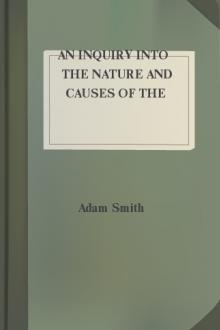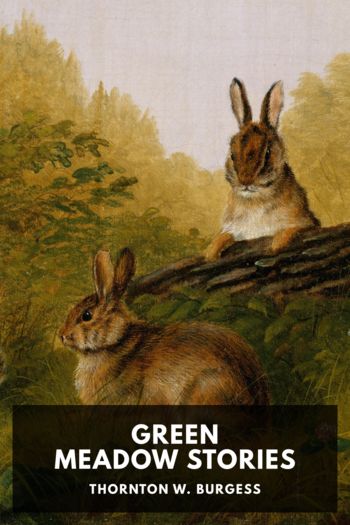The Wealth of Nations by Adam Smith (the best motivational books .TXT) 📕

- Author: Adam Smith
Book online «The Wealth of Nations by Adam Smith (the best motivational books .TXT) 📕». Author Adam Smith
Voyage historique, tom. i, p. 443, 445: “sixteen to eighteen thousand persons of Spanish extraction, a comparatively small number of Indians and half-breeds, the greater part of the population being negroes and mulattoes.” ↩
E.g., Santiago and Callao, Frezier, Voyage, pp. 102, 202; Juan and Ulloa, Voyage historique, vol. i, p. 468; vol. ii, p. 49. ↩
Originally one ship, and, after 1720, two ships, were allowed to sail between Acapulco in Mexico and the Philippines. For the regulations applied to the trade see Uztariz, Theory and Practice of Commerce and Maritime Affairs, trans. by John Kippax, 1751, vol. i, pp. 206–208. ↩
“In order to prevent the great consumption of timber fit for the construction of large ships of war, the East India Company were prohibited from building, or allowing to be built for their service, any new ships, till the shipping in their employment should be reduced under 45,000 tons, or employing any ships built after 18th March, 1772. But they are at liberty to build any vessel whatever in India or the colonies, or to charter any vessel built in India or the colonies, 12 Geo. III, c. 54.” —Macpherson, Annals of Commerce, 1805, AD 1772, vol. iii, pp. 521, 522 ↩
Ed. 1 places “in India” here instead of in the line above. ↩
Above, here. ↩
Ed. 1 does not contain “or at most as twelve” here and two lines lower down. ↩
Newton, in his Representation to the Lords of the Treasury, 1717 (reprinted in the Universal Merchant, quoted on the next page), says that in China and Japan the ratio is 9 or 10 to 1 and in India 12 to 1, and this carries away the silver from all Europe. Magens, in a note to this passage (Universal Merchant, p. 90), says that down to 1732 such quantities of silver went to China to fetch back gold that the price of gold in China rose and it became no longer profitable to send silver there. ↩
Ed. 1 reads “be the principal commodity.” ↩
Ed. 1 reads “chiefly.” ↩
The same words are used below, here. ↩
Postscript to the Universal Merchant, p. 15 and 16. This postscript was not printed till 1756, three years after the publication of the book, which has never had a second edition. The postscript is, therefore, to be found in few copies. It corrects several errors in the book. —Smith
This note appears first in ed. 2. The title of the work referred to is Farther Explanations of Some Particular Subjects Relating to Trade, Coin, and Exchanges, Contained in the Universal Merchant, by N. M., 1756. On p. 1 N. M. claims the authorship of the book “published by Mr. Horsley under the too pompous title of The Universal Merchant.” In the dedication of The Universal Merchant, 1753, William Horsley, the editor, says the author “though an alien by birth is an Englishman by interest.” Sir James Steuart, who calls him “Mr. Megens,” says he lived long in England and wrote the Universal Merchant in German, from which it had been translated (Inquiry Into the Principles of Political Economy, 1767, vol. ii, pp. 158, 292). The Gentleman’s Magazine for August, 1764, p. 398, contains in the obituary, under date August 18, 1764, “Nicholas Magens Esq. a merchant worth £100,000.” —Cannan ↩
The two periods are really five years, April, 1748, to April, 1753, and six years, January, 1747, to January, 1753, but the averages are correct, being taken from Magens. ↩
The 10s. here should be 14s., and two lines lower down the 14s. should be 10s. ↩
Misprinted 13,984¹⁸⁵³⁄₆ in ed. 2 and later editions. ↩
Raynal, Histoire philosophique et politique des établissemens et du commerce des Européens dans les deux Indes, Amsterdam ed., 1773, tom. iii, p. 310. ↩
Raynal, Histoire philosophique, Amsterdam ed., 1773, tom. iii, p. 385. ↩
Ed. 1 does not contain “though manuscript.” ↩
Above, here. ↩
Ed. 1 does not contain “or one to twelve.” ↩
Cantillon gives one to ten for China and one to eight for Japan, Essai, p. 365. ↩
Above, here through here. The exact figure given by Magens, Farther Explanations, p. 16, is 1 to ²²¹⁄₁₀. ↩
Farther Explanations, p. 17. ↩
See Ruddiman’s Preface to Anderson’s Diplomata, etc. Scotiæ. —Smith
Selectus diplomatum et numismatum thesaurus (quoted above, here), pp. 84, 85; and in the translation, pp. 175, 176. But the statement that gold preponderated is founded merely on the fact that the value of the gold coined in the periods 16th December, 1602, to 19th July, 1606, and 20th September, 1611, to 14th April, 1613, was greater than that of the silver coined in the same time, which proves nothing about the proportions in the whole stock of coin. The statement is repeated below, here. The note appears first in ed. 2. —Cannan ↩
Ed. 1 reads “European.” ↩
Ed. 1 reads “European.” ↩
Ed. 1 reads “one fifth part of it, or to twenty percent.” ↩
Above, here and here. ↩
Above, here. ↩
Ed.





Comments (0)